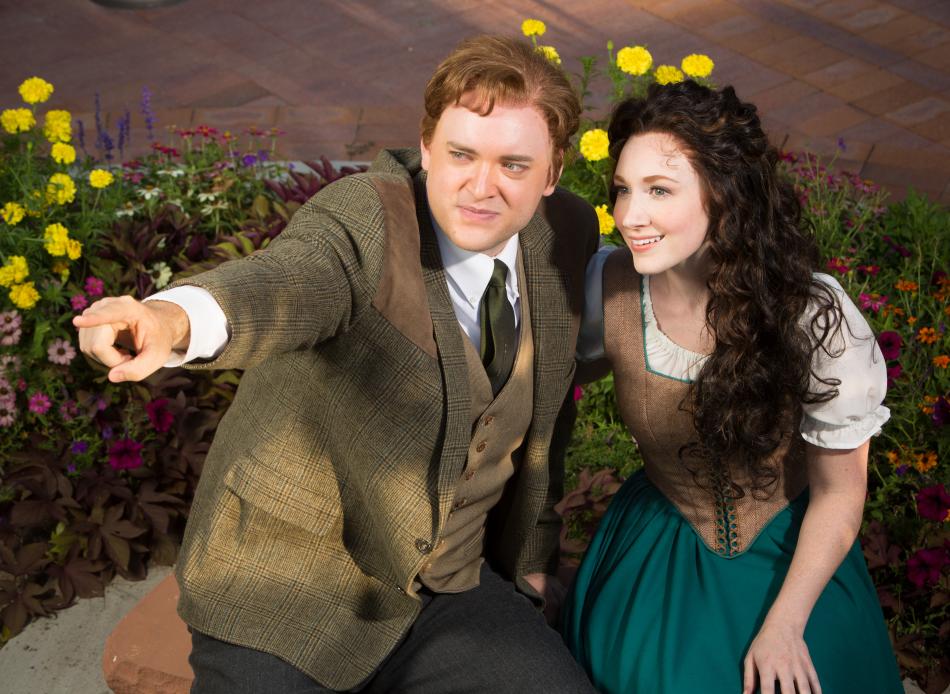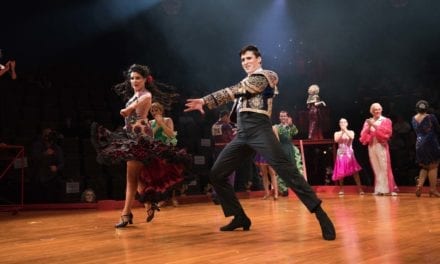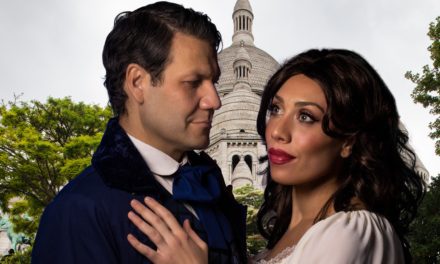WEST VALLEY CITY — Brigadoon opens on Jeff and Tommy, two New Yorkers on a hunting trip in Scotland. After the two become lost in a thick fog, they stumble upon an idyllic Highland village replete with tartan and bagpipes. When the two ask to use a phone, they’re surprised to be answered only by blank stares. Despite all the town’s glaring anachronisms, Jeff and Tommy are quickly distracted by romantic endeavors. Written by Lerner and Loewe, the same partnership behind Paint Your Wagon, My Fair Lady, Camelot, and Gigi, Brigadoon is characterized by the same kind of musical variety, creative storyline, and humor that typify their other works. Even while the story was interesting and allowed space for some emotional complexity in its main characters, Hale Centre Theatre’s production lacked both the momentum and the dramatic strength to make me feel emotionally invested in the outcome of the plot.
The most noticeable flaw in this play was the lack of chemistry I felt between the romantic comedy’s lead couple, Tommy Albright (Kyle Olsen) and Fiona MacLaren (Lisa Zimmerman). While neither member of the couple was particularly convincing, Olsen especially often felt unnatural and his character somewhat put-on. I could follow their growing attraction and eventual love via the words in their dialogue, but the physicality of the relationship felt uncomfortable, and I was unable to see an increased depth in the way the two felt about each other. This may especially have been caused by both members of the couple’s singing styles. While they both had lovely singing voices, neither was particularly keen on enunciation, especially Zimmerman. The incomprehensibility of their lyrics made it difficult for me to follow character or story development that were explained via song.
I was more impressed with the scenes that featured supporting characters. Jeff Douglas (Andrew Hansen) wasn’t the most magnetic sidekick I’ve seen, but his cheeky lines were always a welcome break from the stiff lead characters. His humor was most successful when paired against the desperate romantic advances of Meg Brockie (Elise Groves). Groves’s physical humor and vocal talent shone particularly well in the song “The Love of My Life,” where she managed to portray the wit of her character while also singing in a thick Scottish brogue. Her second humorous number, “My Mother’s Wedding Day,” was still pleasant, but a lot of the lyrics were difficult to understand. I would blame this in part on the entire company’s attempts at singing with Scottish accents.
The entire play suffered from this same difficulty. It’s difficult enough to make the lyrics easily comprehensible in ensemble numbers, and adding Scottish accents made it difficult for me to understand almost any of the words. As one who has lived in Scotland, I can attest to the fact that even the thickest of Highland accents can eventually be understood by an outsider. I can also attest that, aside from the odd Scrooge McDuck and Groundskeeper Willie impression, most Americans are really bad at faking a Scottish accent, and they’re especially bad at making their words understandable. (My fake brogue just sounds like I’ve come down with a simultaneous sore throat and speech impediment. It’s really bad.) While no one’s accent was particularly painful, almost all of them were very hard to understand, especially when put to music. Notable exceptions were the aforementioned Elise Groves as Meg Brockie and Scott Cluff as Charlie Dalrymple. Ben Isaacs and Stephen McBride also portrayed understandable and compelling characters in the parts of Harry and Archie Beaton.
My other two favorite parts of the show were the dance numbers. Both Jean MacLaren (Adrianne Durtschi) and Maggie Anderson (Sarah Poulsen) have their own scene in which they use dance to express their romantic feelings. Both Durtschi and Poulsen had lovely ballet skills and were a pleasure to watch. Choreographed by Jenny Barlow, both dancers were so talented that I could only wish their scenes had been longer.
The costumes (designed by Kristy Draper) were always interesting to look at and were sometimes used effectively for humor. The set (designed by Kacey Udy) was often simple but also proved to be quite versatile, especially during the scene “The Heather On The Hill.” Lighting (designed by Spencer Brown) was flawless. And professional bagpiper Michael Gibbs was a nice touch.
Directed by David Morgan, this play basically got the job done. Lines were said correctly, and songs were in key. Many of the side characters told compelling stories, but the lead characters largely failed to win my sympathies. If you love musical theater for its charming characters and lyric wit, then you might be better off skipping this production.








